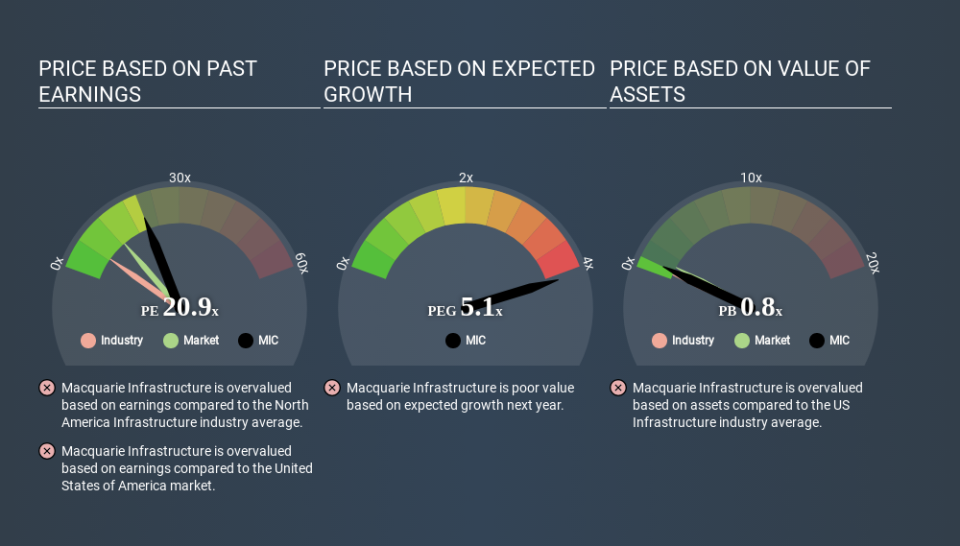A Sliding Share Price Has Us Looking At Macquarie Infrastructure Corporation's (NYSE:MIC) P/E Ratio

Unfortunately for some shareholders, the Macquarie Infrastructure (NYSE:MIC) share price has dived 40% in the last thirty days. That drop has capped off a tough year for shareholders, with the share price down 41% in that time.
Assuming nothing else has changed, a lower share price makes a stock more attractive to potential buyers. In the long term, share prices tend to follow earnings per share, but in the short term prices bounce around in response to short term factors (which are not always obvious). So, on certain occasions, long term focussed investors try to take advantage of pessimistic expectations to buy shares at a better price. Perhaps the simplest way to get a read on investors' expectations of a business is to look at its Price to Earnings Ratio (PE Ratio). A high P/E implies that investors have high expectations of what a company can achieve compared to a company with a low P/E ratio.
Check out our latest analysis for Macquarie Infrastructure
How Does Macquarie Infrastructure's P/E Ratio Compare To Its Peers?
We can tell from its P/E ratio of 20.90 that there is some investor optimism about Macquarie Infrastructure. You can see in the image below that the average P/E (6.5) for companies in the infrastructure industry is a lot lower than Macquarie Infrastructure's P/E.
Its relatively high P/E ratio indicates that Macquarie Infrastructure shareholders think it will perform better than other companies in its industry classification. Shareholders are clearly optimistic, but the future is always uncertain. So further research is always essential. I often monitor director buying and selling.
How Growth Rates Impact P/E Ratios
When earnings fall, the 'E' decreases, over time. That means unless the share price falls, the P/E will increase in a few years. Then, a higher P/E might scare off shareholders, pushing the share price down.
It's nice to see that Macquarie Infrastructure grew EPS by a stonking 47% in the last year. Unfortunately, earnings per share are down 41% a year, over 5 years.
A Limitation: P/E Ratios Ignore Debt and Cash In The Bank
The 'Price' in P/E reflects the market capitalization of the company. That means it doesn't take debt or cash into account. In theory, a company can lower its future P/E ratio by using cash or debt to invest in growth.
While growth expenditure doesn't always pay off, the point is that it is a good option to have; but one that the P/E ratio ignores.
Is Debt Impacting Macquarie Infrastructure's P/E?
Macquarie Infrastructure's net debt is considerable, at 109% of its market cap. If you want to compare its P/E ratio to other companies, you must keep in mind that these debt levels would usually warrant a relatively low P/E.
The Bottom Line On Macquarie Infrastructure's P/E Ratio
Macquarie Infrastructure has a P/E of 20.9. That's higher than the average in its market, which is 13.4. Its meaningful level of debt should warrant a lower P/E ratio, but the fast EPS growth is a positive. So it seems likely the market is overlooking the debt because of the fast earnings growth. What can be absolutely certain is that the market has become significantly less optimistic about Macquarie Infrastructure over the last month, with the P/E ratio falling from 34.6 back then to 20.9 today. For those who don't like to trade against momentum, that could be a warning sign, but a contrarian investor might want to take a closer look.
When the market is wrong about a stock, it gives savvy investors an opportunity. As value investor Benjamin Graham famously said, 'In the short run, the market is a voting machine but in the long run, it is a weighing machine. So this free visualization of the analyst consensus on future earnings could help you make the right decision about whether to buy, sell, or hold.
You might be able to find a better buy than Macquarie Infrastructure. If you want a selection of possible winners, check out this free list of interesting companies that trade on a P/E below 20 (but have proven they can grow earnings).
If you spot an error that warrants correction, please contact the editor at editorial-team@simplywallst.com. This article by Simply Wall St is general in nature. It does not constitute a recommendation to buy or sell any stock, and does not take account of your objectives, or your financial situation. Simply Wall St has no position in the stocks mentioned.
We aim to bring you long-term focused research analysis driven by fundamental data. Note that our analysis may not factor in the latest price-sensitive company announcements or qualitative material. Thank you for reading.

